Understanding Half Sizes in Ring Measurements


Intro
When it comes to choosing the perfect ring, understanding the nuances of sizing can make a substantial difference. This article sheds light on the often overlooked yet vital concept of half sizes in ring measurements. Many people might not realize that these increments matter not just in terms of comfort but also in aesthetics and design. The journey through ring sizing is complex yet fascinating, as it intertwines personal preference with practical considerations.
With an increasing number of jewelers offering custom designs and the rising popularity of personalized jewelry, mastering the art of ring sizing, particularly half sizes, is essential.
So, strap in as we navigate through the ins and outs of half sizes, how they cater to individual quirks, and their importance in achieving the right fit for everyone.
The Basics of Ring Sizing
Understanding the basics of ring sizing plays a crucial role in ensuring that both jewelers and customers get the best fit possible. When it comes to purchasing a ring, whether it's for an engagement or a special occasion, one major aspect that can’t be overlooked is the correct size. If the size is off, it might mean the difference between comfort and frustration.
In this section, we will delve into the key elements involved in ring sizing.
Understanding Ring Sizes
When we discuss ring sizes, we enter a world of precision where even the tiniest millimeter can matter. Typical ring sizes are measured in a variety of ways depending on the region, with some countries using standard numerical systems while others use letters or even custom scales.
For instance, the US utilizes a numerical system ranging from 3 to 16, while countries like the UK opt for a letter system from A to Z. How these numbers and letters correlate can be confusing at first. However, for jewelers and enthusiasts alike, understanding these differences becomes essential. Each unique size reflects the circumference of the ring, which is critical when fitting a piece for comfort.
Some enthusiasts use measurement tools like ring sizers, or even household items to gauge their size. The challenge? Variations can occur based on temperature, time of day, and even physical activity, which brings us to the next important aspect—accuracy.
The Importance of Accurate Sizing
Accurate ring sizing can not only enhance comfort but also ensures the longevity of the ring. A ring that fits well is less likely to slip off and get lost—nobody wants to lose a treasured piece!
Here are some points to consider regarding why accuracy is vital in ring sizing:
- Comfort: A ring that fits properly is comfortable to wear daily. It won’t pinch or slide off, allowing the wearer to go about their day without constant adjustments.
- Durability: Rings that are too tight may bend or break over time, especially with daily wear. A snug fit combined with enough room to breathe ensures the integrity of the metal.
- Replacement Costs: The outlay for resizing or purchasing a new ring because of a sizing error can be avoided through proper measurements.
“A well-fitted ring feels like a second skin, complementing your style without complaint.”
For those who find themselves in unique situations—like selecting a ring for a partner as a surprise—knowing the right size can take a bit of research or some detective work. Family members or friends can be enlisted for help.
Ultimately, understanding the elements of ring sizing sets the foundation for a satisfying jewelry experience, whether that’s selecting the perfect piece or ensuring an ideal fit. Few things rival the confidence that comes with knowing you’ve made the right choice.
Half Sizes: An Overview
Half sizes play a crucial role in the realm of ring measurements, particularly for those who are meticulous about fit. The concept of half sizes bridges the gap between whole sizes, providing a more tailored fit for fingers that don’t conform to traditional sizing. This section will discuss what half sizes are, their historical context, and emphasize their significance in ensuring comfort and aesthetics in jewelry design.
What Are Half Sizes?
Half sizes refer to ring sizes that fall between the standard whole sizes. For instance, if a standard size 7 is too snug and an 8 feels loose, a half size 7.5 offers that much-needed compromise. This aspect becomes particularly vital when you consider that fingers can change sizes due to various factors like temperature or time of day. It's much like finding the just right porridge in the Goldilocks story.
The introduction of half sizes is not merely a fashion statement; it’s all about comfort and functionality. A ring that fits well ensures it remains securely on the finger yet is easy enough to slide off when necessary. If you’ve ever worn a ring that pinches or spins around, you understand how critical this subtle difference can be.
Historical Context of Half Sizes
So, where did this clever sizing system come from? Historically, rings were primarily made in whole sizes, simplifying production but often leaving many wearers in a bind. The transition to half sizes can be traced back to increased consumer demand for more accurate fit and comfort in jewelry design. Jewelers began noticing that many customers sought a more precise fit that whole sizes simply could not accommodate.
In fact, as jewelry design evolved, so did the understanding of the human anatomy. With intricate jewelry designs becoming more sophisticated, the need for a better fit became apparent. Half sizes were born out of necessity, ensuring that rings could be worn comfortably without compromising aesthetic value.


"Every finger is unique, and half sizes acknowledge this individuality in an elegant manner."
This history shows that even in the world of jewelry, innovation often arises from practical needs. As the art of jewelry making continues to progress, understanding the importance of these sizing nuances becomes essential for jewelers and consumers alike, allowing for truly personalized jewelry experiences.
Why Half Sizes Matter
When it comes to ring measurements, the significance of half sizes can’t be overstated. Many believe that achieving the perfect fit is just about knowing one’s full ring size, yet this is often only part of the equation. Understanding why half sizes exist elevates the experience of both the wearer and the jeweler.
Enhanced Comfort in Wearing
Half sizes exist to cater to the nuances of individual finger shapes and sizes. People’s fingers aren’t all the same, even if they carry the same numeric size. For instance, you may have heard someone say, "My fingers swell in the heat," or "My fingers shrink when it's cold." These fluctuations can lead to discomfort when wearing a ring that’s only a full size away from what’s needed.
By offering half sizes, jewelers provide an option that adds a comfortable fit without having to compromise on style. It’s not just about whether the ring slips off or feels too tight; it’s about a sense of overall comfort that comes from a well-fitted piece. Imagine the difference between trying to squeeze your hand into a too-small glove or a nice-fitting one that lets your fingers breathe. The same goes for rings.
"Half sizes are the unsung heroes of comfort in ring wearing. They turn potential pinching into a smooth experience."
Consider a practical example: imagine someone whose finger size is 6 solidly but by selecting a size 5, there can be discomfort while 7 feels too loose. A half size, in this case, bridges the gap perfectly. The addition of half sizes often transforms the entire wearing experience, enabling someone to wear their cherished ring all day without the need to constantly adjust it.
Aesthetic Proportions
Beyond comfort, half sizes impact the aesthetics of a ring. When a ring fits too tightly or loosely, it can alter its appearance. Think of a delicate band. If it slips too far down the finger, it loses its visual integrity and might not sit as intended against the skin. Likewise, a ring that's too tight can cause unsightly bulges at the finger base, which detracts from its grace.
Getting the size right is also about proportion and balance. A beautifully designed piece deserves to be showcased correctly. Half sizes ensure that the ring sits comfortably atop the finger, showcasing design features like engraved details or gemstone settings in their best light.
In this way, half sizes are not merely about numbers but about harmony and elegance in presentation. A well-fitted ring speaks to both its wearer and the artistry of the design. A snug fit enhances all aspects of its appearance, allowing the piece to shine fully.
Ultimately, whether it is enhancing comfort or ensuring aesthetic appeal, the importance of half sizes in rings cannot be overlooked. They enable rings to fulfil their function in the most delightful way, making the experience of wearing them all the more exquisite.
Measuring Ring Sizes
Measuring ring sizes is fundamental not only for basic purchases but also for facilitating custom creations. When we discuss half sizes, accurate measuring takes on even greater significance. In jewelry, a ring must feel both secure and comfortable. If a ring is too loose, it can easily slip off, while if it's too tight, it can create discomfort or even pain.
In this context, achieving the perfect size is critical. A poorly sized ring can taint the joy of wearing it, regardless of its craftsmanship or beauty. Thus, understanding the nuances of measuring is paramount for anyone venturing into the world of rings, be it a gemstone enthusiast or a jewelry designer.
Professional Tools and Techniques
When it comes to professional measuring, jewelers employ a variety of specialized tools to ensure accuracy. The most common tool is the mandrel, a tapered rod where rings are slid on to find their corresponding size. Jewelers also use sizers that resemble small, circular bands placed directly on the finger to gauge fit.
Another valuable tool is the ring gauge, which consists of a set of metal or plastic rings of various sizes, allowing clients to determine their size conveniently. Professionals often recommend this method, as it gives an instantaneous feel for how a range of sizes will fit.
For precision, professionals may also use digital calipers, which can provide an accurate measurement of both the inner diameter and width of a ring. This technology is especially useful in cases where intricate designs complicate traditional measuring methods.
"Getting the right fit is as important as the ring itself; it’s the basis on which all else stands."
DIY Measuring Methods
For those who prefer a hands-on approach, several methods for DIY measurements exist. One popular method involves using a piece of string or a strip of paper. The idea is simple: wrap the string around the base of the finger, mark where it overlaps, and measure the length against a ruler to find the circumference. From this measurement, a size chart can be referenced to identify the corresponding ring size.
Another technique is to use an existing ring. Place the ring on a flat surface and measure its inner diameter with a ruler. This gives a good gauge of size since each size corresponds to a specific diameter. Note, however, that different styles and widths can affect how rings fit, so it’s advisable to consider the nature of the new ring when using this method.
To avoid errors, it’s wise to measure when the fingers are at their largest - usually later in the day. Fingers can swell due to heat or activity, and accounting for this can prevent unpleasant surprises when trying the ring on for the first time.
In short, having an accurate measure can save much hassle, whether using professional tools or creative DIY tactics. The world of rings is not just about aesthetics but also about fit, comfort, and personal expression.


Choosing the Right Size
Selecting the right ring size goes beyond just fitting; it’s an essential part of the overall experience of wearing jewelry. The nuances involved in finding that perfect size can significantly affect how comfortable and pleasing a ring is for the wearer. Fortunately, understanding what contributes to ring sizing specifics can guide anyone in making the best choice.
Factors Influencing Size Selection
When it comes to choosing a ring size, several factors play a significant role. It’s not merely about measuring the finger or guessing based on another ring. Here are some key influence:
- Finger Shape and Temperature: A finger's shape can vary, even throughout the day. For example, fingers can swell in heat or soften in colder climates. This is crucial to consider, as it may affect how snugly a ring fits.
- Ring Design: The style of the ring itself can impact fit. Wider bands, for instance, often feel tighter than more slender ones. If you’re considering a chunky statement piece, you might want to think about a slightly larger size.
- Lifestyle Considerations: Are you an active person? If so, rings may need to allow for a bit of flexibility. Someone who plays sports or works with their hands might require a size that accommodates a little movement without risking the ring slipping off.
- Personal Preference: Some people prefer a tighter fit, while others like a looser feel. This can depend on personal comfort levels and the type of activity they partake in when wearing jewelry.
In short, consider these elements closely when selecting a size, as they can transform the feeling of the ring from uncomfortable to blissfully appropriate.
Common Myths About Ring Sizes
Ring sizing is often clouded by myths that circulate around informal conversations and online forums. Let’s bust some of them:
- One Size Fits All: Many think a single size will suffice for everyone, which is false. Everyone’s fingers are unique, just like their preferences and lifestyles. Getting a proper measurement is crucial.
- Half Sizes Are Insignificant: Some may regard half sizes as negligible, but they can make all the difference. A half size can be the difference between a snug fit and a ring that slips off too easily.
- You Can Only Get Sized at a Jeweler: Many believe sizing should only happen at a professional. While it’s highly recommended, you can use accessible methods at home to determine your size, but always seek professional advice when in doubt.
- Diet and Sizing Don’t Matter: A common thought is that weight changes don’t affect ring size. However, weight fluctuation, whether gain or loss, can have a tangible effect on how rings fit.
"Getting your size right means you won’t need to worry about your ring being too tight or too loose; that’s where comfort truly begins."
Ultimately, uncovering the truths about ring sizing can set a solid foundation for both comfort and style. Remember that finding the ideal fit isn’t just about numbers; it is about how a ring aligns with your body and lifestyle.
Custom Rings and Half Sizes
When it comes to the delicate art of jewelry making, the world of custom rings stands apart. These bespoke creations allow for a unique blend of personal expression and tailored fit, especially when half sizes come into play. Understanding how half sizes impact custom ring designs is critical for both jewelers and those commissioning pieces. A half size can mean the difference between a comfortable fit and a piece that slips or pinches.
Creating a ring that precisely aligns with someone's individual measurements can enhance not just aesthetics but also the experience of wearing the piece. Every individual has unique dimensions, and half sizes provide that extra bit of flexibility needed to achieve the perfect fit. For those seeking a ring that will be worn daily, this consideration is vital. "A ring should feel like a second skin," they often say, underscoring the importance of accurate sizing.
Being mindful of one’s preference can lead to an elevated value of the piece, both personally and financially. Additionally, the artistry involved in custom ring creation necessitates an understanding of how materials might behave under different sizes, and this can be where half sizes shine yet again.
The Customization Process
Custom ring creation starts with a detailed conversation about preferences and needs. This often involves a discussion of design, including the choice of metal and setting. When a client mentions a half size, it plays a pivotal role in the designing process, as jewelers can adjust their measurements accordingly to ensure precision.
- Initial Consultation: The first step often includes understanding the customer’s vision for the ring. This stage may involve discussing materials, styles, and of course, the desired ring size.
- Creating a Design: Once preferences are set, sketches are usually made to visualize the intended design. This is also when jewelers must take note of whether the client may lean towards a half size, as it alters how the piece will take shape.
- Prototyping and Fitting: It’s common for jewelers to create a prototype of the ring for fitting. This is when the half-size significance becomes truly apparent, as adjustments can be easily made before the final production.
- Final Production: After satisfactory fitting, the piece is finalized and constructed. Having half sizes facilitated earlier on can guarantee a stunning balance between design and comfort.
Considerations for Custom Orders
Order customization goes beyond just design preferences; it also incorporates careful consideration of how materials respond to size adjustments. Different metals behave differently, and the weight of gemstones can affect how a ring feels when worn.
- Material Selection: The type of metal can impact the ring's ability to be adjusted. Precious metals like gold and platinum are generally more malleable, allowing for alterations in size, including going up or down by half sizes. For instance, tungsten is more difficult to resize and requires precise measurements from the start.
- Stone Settings and Weight: Heavier gemstones necessitate a more secure setting. If a client chooses a substantial gemstone yet requires a half size adjustment, the jeweler must ensure that the setting retains stability and the ring remains comfortable to wear.
"In the world of custom rings, half sizes can become pivotal elements in the story of a piece. Every adjustment tells its own tale of craftsmanship and personal touch."
- Future Adjustability: Clients should also consider if they might need adjustments in the future. It's worth discussing with jewelers how a ring can be resized or what can be done if a half size adjusts.
In summary, the blend of custom rings and half sizes fundamentally enhances the experience of jewelry-making and ownership. From conversations, designs, and material choices, understanding how half sizes influence each part of the process will ultimately lead to a piece of jewelry that resonates on a personal level.
The Impact of Material on Sizing
When it comes to ring sizing, the material of the ring plays a crucial role that many may overlook. It's not just about finding that perfect fit; different materials can behave in unique ways that affect how a ring feels and sits on the finger. For gem enthusiasts and jewelry designers, understanding these characteristics can significantly aid in making informed choices for both aesthetic and functional aspects of ring design.
Different Metals and Their Behaviors


Each type of metal used in ring making has its own physical properties, which can influence how the ring fits and wears over time. Here are a few key metals commonly used in jewelry and their behaviors:
- Gold: Whether it's yellow, white, or rose gold, this metal is often alloyed with other metals to enhance its durability. The softness of gold means that it can easily be stretched or compressed. Thus, when selecting a size, considering the wearer's lifestyle is essential, as a snug fit may become loose over time due to the softness of the material.
- Platinum: Known for its strength and resistance to scratching, platinum is a popular choice for engagement rings. Rings made from platinum keep their shape better than others, which may result in a more consistent size over time. However, if a platinum ring needs resizing, the process can be more complicated due to its density and strength.
- Silver: Sterling silver is prone to tarnishing and may not maintain its shape as well as gold or platinum. If someone opts for silver rings, keeping an eye on the fit is vital, as changes in temperature and humidity can lead to expansion or contraction.
The unique behaviors of these metals underline the importance of consulting with a jeweler who understands how different materials will react over time. If the ring isn't consistently sized to the finger, it might slide around or pinch, leading to discomfort.
Gemstone Weight and Settings
The weight of gemstones set in the ring can also affect how the ring sits on the finger. A heavier stone might require a more secure setting to prevent it from tilting or causing the ring to spin. When considering the overall fit, keep in mind:
- Balance: A ring with a large gemstone needs to have a properly adjusted band. If the band is too thin, it could bend under the weight of a large stone, affecting the fit and comfort.
- Setting Style: The style of the setting can influence how the ring fits. For example, a bezel setting provides more stability than a prong setting, as it encases the stone more securely, reducing the risk of it pushing the ring out of shape.
- Design Consideration: When designing custom rings, it’s not just the metal that matters; the designer should consider the total weight of the ring, including the stone and how that weight interacts with the wearer’s finger size.
Proper understanding and communication of these aspects can result in a ring that feels both comfortable and looks stunning.
The impact of material on sizing highlights that selecting the right ring is more than just a judgment call—it requires a keen understanding of how various materials will respond to wear and tear and how they perform in different design contexts. Each material brings its own set of considerations, which must be addressed for optimal comfort and style in jewelry-making.
Adjusting Ring Sizes
Adjusting ring sizes plays a crucial role in the overall experience of wearing jewelry, particularly for those who appreciate the finer things in life. A well-fitted ring is not only a matter of comfort but also impacts the aesthetics and durability of the piece. This section will delve into the importance of adjusting ring sizes, focusing on techniques for both sizing up and down, and the considerations that must be taken into account during these processes.
When it comes to rings, many people believe a size is just a number, but this 'number' can significantly affect how a piece is worn. An ill-fitting ring, whether too tight or too loose, can lead to discomfort and even loss of the item. Understanding how to effectively adjust ring sizes allows both collectors and designers to ensure that their pieces can be adapted for a perfect fit, thus enhancing the joy and value of these pieces.
Techniques for Sizing Up
There may come a time when a ring that once fit like a glove suddenly feels a little too snug. This could be due to various reasons—perhaps the wearer has gained weight, or the weather has impacted the size of their fingers. Sizing up is an effective way to remedy this, and here are a couple of techniques often employed:
- Laser Resizing: A modern method, where a jeweler uses a laser to cut and weld the band. This technique minimizes damage to the ring and is particularly effective for intricate designs or metal types such as platinum that require extra care.
- Adding Metal: For more traditional adjustments, jewelers can add more metal to the band by inserting a new piece and soldering it in place. This method is beneficial for thicker bands, although it requires careful matching of the material to ensure a seamless look.
"A ring that fits just right is worth its weight in gold, but an ill-fit can lead to missteps in style and comfort."
Each technique has its pros and cons, so it's important for the wearer to consult with a professional to determine the best route forward.
Techniques for Sizing Down
Conversely, there are also moments when a ring must be sized down—often due to weight loss or sometimes a natural shrinking of the fingers over time. Techniques for resizing down can be slightly more challenging, but here are common methods:
- Removing a Section: Jewelers typically remove a small section of the band and solder it back together. This method is straightforward but requires precision to avoid disrupting the ring's original design.
- Pinching Method: Some jewelers opt for a less invasive approach by gently pinching the band to reduce the size. However, this method isn't suitable for every type of ring and can weaken the band if not done properly.
It’s worth noting that no matter the direction of resizing, a professional should always be consulted to ensure that these adjustments are made carefully, maintaining the integrity of the piece.
Ultimately, the goal of adjusting ring sizes is to ensure that each piece not only tells a story but does so while fitting comfortably and beautifully on the wearer's finger. Understanding these techniques can open up new possibilities for customization and enhance the personal connection individuals have with their jewelry.
Ending
Summary of Key Considerations
When it comes to ring sizing, particularly the half sizes, several key points should resonate:
- Personal Comfort: Half sizes allow rings to fit snugly without pinching or feeling insecure. A ring that fits well enhances the overall experience of wearing jewelry.
- Style Flexibility: Half sizes provide jewelry designers with the ability to create more personalized pieces. This aspect can lead to a better alignment with the wearer’s specific preference.
- Market Connection: For jewelers and retailers, offering half sizes can sharpen their competitive edge in the market. Customers often appreciate options that cater to their unique hands and styles.
In essence, half sizes are not just a minor distinction in the world of rings; they represent a tailored approach to jewelry that considers both functionality and aesthetic value.
Future Perspectives on Ring Sizing
Looking ahead at ring sizing, especially with the prevailing trend towards customization, we can anticipate some exciting developments:
- Technological Integration: The continuous advancement in 3D printing and scanning technology may revolutionize how rings are sized, making custom half sizes accessible at lower costs for all.
- Inclusion of Diverse Materials: As new materials and techniques are developed, the flexibility in offering half sizes will also grow. Jewelers may experiment with softer metals or innovative designs that accommodate shifts in size due to environmental factors.
- Consumer Knowledge Growth: As consumers become more educated about jewelry, the potential for demand for half sizes will likely increase. Awareness campaigns can enlighten individuals on the importance of fit and comfort, encouraging them to seek more personalized fitting options.
The dynamics of ring sizing are evolving, and half sizes will undoubtedly play a crucial role in this progression, paving the way for a more user-friendly and stylish future.







